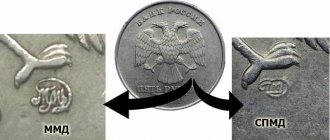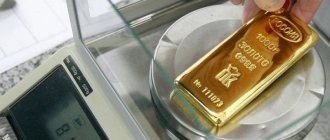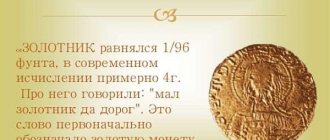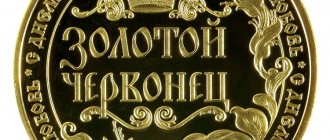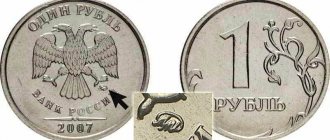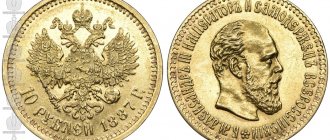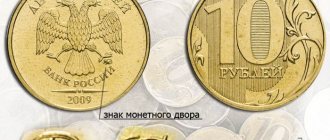Weight of Russian coins
Like the Europeans, the Russian people in coinage were guided by the value of the precious metal, accepting coins of neighboring states not by face value, but by weight. It was not the banknote of a foreign power itself that was evaluated, but the gold and silver in its composition. Until the 18th century, most domestic coins were minted from silver. The method by which the minting was carried out is called wire: a piece was pinched off from a silver wire, flattened or melted, and then struck with a hammer - a hammer, on the striking part of which a drawing or inscription was carved. Due to their characteristic appearance, numismatists call these coins “scales.” After the reform of Elena Glinskaya, 300 kopecks, or 600 money, or 1200 half rubles were minted from a silver hryvnia.
As a result of the reform of Elena Glinskaya, a unified monetary system emerged in Rus', in which 300 kopecks, or 600 money, or 1200 half-shek, were minted from a hryvnia of silver weighing 204 grams. Therefore, a penny of that time weighed 0.68 grams, money - 0.34 grams, and a half - 0.17 grams.
Subsequently, with a shortage of silver, the penny began to lose weight, or, as they say, “lose weight.” They tried to solve the problem of silver shortage by introducing copper money into circulation, but without success, and one of these attempts led to a copper riot. Only Peter the Great succeeded in introducing copper coins into circulation. The first half coin and money made of copper appeared in 1700. The copper penny was added in 1704, although the tiny silver penny (0.28 grams) continued to be minted until 1718. The issue of copper money was also subject to weight standards. The coin stack (the number of coins of the same denomination that is minted from a certain weight) was strictly regulated and could only be changed by decree of the emperor or empress. In the Russian Empire, from a pound of copper (16.38 kg), at different periods a coin was minted in the amount of:
- 1700-1702 – 12 rubles 80 kopecks
- 1702-1704 – 15 rubles 44 kopecks
- 1704-1718 – 20 rubles
- 1718-1730 – 40 rubles
- 1730-1755 – 10 rubles
- 1755-1757 – 8 rubles
- 1757-1762 – 16 rubles
- 1762-1763 – 32 rubles
- 1763-1810 – 16 rubles
- 1810-1830 – 24 rubles
- 1830-1839 – 36 rubles
- 1839-1848 – 16 rubles
- 1849-1867 – 32 rubles
- 1867-1917 – 50 rubles
The last domestic copper kopecks were issued under the USSR in 1924. Their mass exactly corresponded to the similar denominations of Nicholas II. But soon the weight value of the metal ceased to play a major role. Small denominations are minted from light aluminum bronze, having significantly decreased in size, and silver is no longer used in the manufacture of large ones. Since then, the weight and size of settlement signs have been calculated based on their ease of handling.
"Heavyweights" of the Russian Empire
The long period of monetary circulation of the Russian Empire surprises and delights numismatics collectors with rare and unique examples of coins, among which there was also a place for massive items.
Coin-plates
Copper banknotes of a non-standard square shape were minted during the reign of Empress Catherine I, but the very idea of introducing such unusual products into circulation belonged to Peter the Great, although he did not see its implementation.
There are several types of boards, classified depending on the denomination:
- The ruble payment is one of the rarest in Russian history. The weight of the square banknote reaches 1638 g, dimensions – 188x188 mm. Due to its rarity, it is difficult to name its exact value. At auction, the price of such a product can reach 100 thousand dollars.
- Poltina-plata is no less rare than a square ruble. The half-ruble coin weighs 819 g and measures 139x139 mm.
- Half-and-a-half payment is a quarter or a 25-kopeck piece. The weight of such a half-ruble is almost 410 g, the size (which is noteworthy) is not inherent in a square: 93x95 mm.
- Hryvnia-plata - a ten-kopeck piece - is a fairly frequent “guest” at large auctions, where the price for it usually starts at 15 thousand dollars. The weight of the product reaches 163.8 g.
- 5 kopecks-plate – the list of coins-plates is completed by a modest five-kopeck coin weighing 81.9 g and measuring 45x45 mm. It is also rare and comes with an impressive price tag.
Sestroretsk ruble
This unusual giant coin looks like a hockey puck, but its weight is not that of a puck: 926 g with a diameter of 72.5 mm and a thickness of 26 (!) mm. Several test copies (about a dozen) were created. The main purpose of releasing the product was to provide paper notes.
The ruble received its name in honor of the Sestroretsk arms factory, where regular minting of banknotes was planned. But this money never made it into circulation for a banal reason: the dimensions were too large. By the way, the coin is considered not only one of the largest, but also the most expensive. Thus, at an auction, a copy of the Sestroretsk ruble was once sold for more than 3 million rubles (50 thousand Swiss francs).
Siberian coin
It was released into circulation, so the chances of finding one are higher, but the price, of course, is not so high: on average, the cost of one copy is 4-5 thousand rubles. The weight of the product is 65.52 g. The production period was short (18 years) and was geographically limited to the territory of Siberia.
The reason for this is simple: in the distant 18th century, the delivery of coins from St. Petersburg to areas of the empire that were poorly developed at that time was difficult, and Catherine II decided to mint a special coin for the Siberians. It is noteworthy that a special copper, “Kolyvanovskaya”, was used to make the banknote. It is a by-product of the production of precious metals; accordingly, the content of silver and gold in it was increased.
How much do 10 kopecks weigh?
If the question had indicated not weight, but diameter, the answer would have been unchanged since the time of Paul the First. But the weight directly depended on the silver, the sample of which underwent changes. So Anna Ioannovna’s ten-kopeck piece was made from 802-grade silver, and it weighed 2.59 grams. Under Ivan Antonovich and Elizabeth, the 750th sample of metal was already used, and since 1746 the weight has been reduced to 2.42 grams. Peter the Third transfers the ten-kopeck denomination to the group of copper coins, which leads to a dramatic change in weight - 51.19 grams. Catherine the Second returns the silver ten-kopeck piece, but with her it already weighs 2.37 grams. At the end of her reign we will again see 10 kopecks made of copper (51.19 g). Pavel the First mints silver coins from 868-carat metal. The weight of the dime first increases to 2.93 grams, but then sharply drops to 2.07 grams. He remains the same under Alexander and Nicholas. However, during the last decade, heavy (45.45 g) ten-kopeck coins were also minted from copper. Alexander II consistently reduces the silver standard from 868 to 500 (billion). The weight of our denomination is also reduced to 1.8 grams. It remained in this weight until the 30s of the 20th century, when cupronickel replaced silver.
Comments:
Hello!
My great-grandmother said that her father: “Measured gold in buckets.” This phrase is passed down from generation to generation. I have been looking for information for a long, long time, WHAT buckets are we talking about? (how rich was our family before the revolution?) This apparently happened in the 19th century - my great-grandmother was born at the end of the 19th century. Help me please. THANK YOU. 05/16/2012 at 17:24:10
Most likely, your great-grandmother wanted to show with this phrase that her father was very rich. It’s just a saying, like: “Money doesn’t matter to chickens.” In fact, gold was not measured with any buckets.
Author: Admin 05/17/2012 at 02:30:31
To add a comment, register
Weight of Russian coins in grams
Why is weight given so much attention? Because this is the most important indicator of the authenticity of the coin being examined. When displaying a copy on a numismatic forum, do not be surprised by the stern question “Where is the photo on the scale?” The weight of the Peter's ruble is 28 grams. , under Catherine the Great, a ruble weighs 24 grams. , and the ruble of the last emperor of Russia weighs 20 grams. If the tested scales show serious deviations from the weight norm, then something is wrong with the coin. Adjusting the mass to the true value has always been a rather difficult task for counterfeiters. They had to vary either the diameter or the thickness of the “product”. Nowadays, when the numismatic market is overflowing with copies, weighing a coin is a mandatory safety precaution when purchasing. Where can I find out the exact weight of Russian coins? To do this, use only verified catalogs (including electronic ones). The Rarity project is an extensive electronic catalog of coins from Russia and around the world, where you can find out the weight of any coin.
How much do Bank of Russia coins weigh?
Modern coins also have accurate weight characteristics. Of course, an individual specimen may deviate from the standard value, but the deviations will be within the acceptable range.
- 1 kopeck - 1.5 grams
- 5 kopecks - 2.6 grams
- 10 kopecks (1997-2006) - 1.95 grams
- 10 kopecks (2006-2015) - 1.85 grams
- 50 kopecks (1997-2006) - 2.9 grams
- 50 kopecks (2006-2015) - 2.75 grams
- 1 ruble (1997-2009) - 3.25 grams
- 1 ruble (2009-present) - 3 grams
- 2 rubles (1997-2009) - 5.1 grams
- 2 rubles (2009-present) - 5 grams
- 5 rubles (1997-2009) - 6.45 grams
- 5 rubles (2009-present) - 6 grams
- 10 rubles - 5.63 grams
- 10 rubles bimetal (2000-2016) - 8.4 grams
- 10 rubles bimetal (2017-present) - 7.9 grams
- 25 rubles – 10 grams
When determining the mass of a specific coin, one must remember that in 2006 the Bank of Russia abandoned the minting of the ten-kopeck piece and the fifty-kopeck piece in non-magnetic brass and switched to magnetic steel with plating. In 2009, magnetic steel with galvanic coating was also used for minting ruble denominations.
How much is this in volume?
The sizes of banknotes are approved by the Central Bank. For banknotes of 50, 100, 200 and 500 this is 150 * 65 millimeters, for banknotes of 1,000, 2,000 and 5,000 rubles - 157 * 69 millimeters.
It is difficult to measure the thickness of one bill, so they usually count it in packs - 100 bills have an average thickness of 12.5 millimeters
(but if, for example, it is older and worn-out money, it may be thicker).
From here you can calculate how much, for example, a cubic meter of money is. Since they won’t fit perfectly into a cubic meter, and we won’t be cutting packs, we’ll round up the quantity:
- in banknotes of 50, 100, 200 and 500 rubles - 7 packs per meter in length, 15 in width, 80 in height, a total of 8,400 packs
; - bills of 1000, 2000 and 5000 rubles - 6 packs per meter long, 15 wide, 80 high, a total of 7200 packs
.
Therefore, it turns out that a cubic meter of money can contain the following amounts:
| Denomination | Number of bills | Amount, million rubles | Denomination | Number of bills | Amount, million rubles |
| 50 | 840000 | 42 | 1000 | 720000 | 720 |
| 100 | 840000 | 84 | 2000 | 720000 | 1440 |
| 200 | 840000 | 168 | 5000 | 720000 | 3600 |
| 500 | 840000 | 420 | 10,000 (if released) | 720000 | 7200 |
It turns out that in a cubic meter of packs of 50 rubles you can count 42 million
, and at 5,000 rubles – 3.6 billion rubles. And almost 3 cubic meters of money were found on Colonel Cherkalin.
Weight of 1 kopeck in Russia
But the penny has been stable for two decades. And this saves knowledgeable people a lot of time! Knowing that a modern penny is one and a half grams of metal, we will not count a mountain of penny coins. We weigh them and take two-thirds of the displayed value, thereby obtaining the quantity and total amount. Under the USSR, a penny weighed exactly one gram. Since 1926, the weight of one, two, three and five kopecks corresponded to their face value, which made it possible not only to accept coins by weight, but also to use small coins as improvised weights.
With the help of weighing, numismatists easily and simply separate the expensive mix-ups of three kopecks on a two-kopeck piece from the colored coins. The weight of the original in nickel silver is 3.4 grams, and the coated troyak will show 3 grams when weighed. with acceptable deviations. We hope that our little research has proven to you how important weight characteristics are in numismatics. Scales are a necessary item in the arsenal of any serious numismatist.
